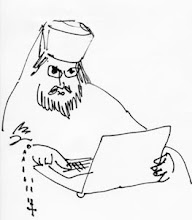 Continued from part two.
Continued from part two.Fr John Meyendorff's interpretation of St Dionysius the Areopagite in A Study of Gregory Palamas was sharply challenged by the late Fr John Romanides in a two-part review essay. (33) Fr Romanides took issue with Fr Meyendorff's entire portrayal of St Gregory's thought, criticizing his "imaginative theories concerning Palamite monisitc prayer and anthropology, and Incarnational and sacramental heart mysticism." (34) Fr Meyendorff, according to Fr Romanides, was engaged in an "obsessed struggle to depict Palamas as an heroic Biblical theologian putting to the sword of Christological Correctives the last remnants of Greek Patristic Platonic Aphophaticism and its supposed linear descendants, the Byzantine Platonic-nominalistic humanists." (35) Romanides continues, in typically polemic fashion:
Since Dionysius the Areopagite is supposed to be the big bad boy of Patristic Platonism which produced Barlaamite nominalism, Father John is forced into a peculiar position by Palamas' obvious and, one may say, even unconditional acceptance of Pseudo-Dionysian authority. To counteract this difficulty, Meyendorff presents Palamas as constantly (whether consciously or unconsciously is not always clear) applying to the theology of St Dionysius Christological correctives, some of which we have already dealt with. In contrast to this, Meyendorff, strangely enough, does not point out those csaes in which Barlaam misinterprets the Areopagite. Nor does he even point out those instances in which Palamas interprets St Dionysius more accurately than Barlaam. For that matter, he never once demonstrates a single case in which Barlaam's interpretation of Dionysius is more accurate than that of Palamas. He merely presents us with an untested theory. (36)Romanides further argues that, if Meyendorff is correct, he has provided the necessary presuppositions to conclude that if the Church had remained faithful to the thought of Dionysius, "Barlaam and not Palamas would now be a saint and Father of the Church. That this did not happen was apparently due to Meyendorff's fancy that St Gregory Palamas fooled everyone into thinking that this interpretation of Pseudo-Dionysius was the correct one." (37) Finally, Romanides concludes that in the dueling interpretations of Dionysius, Barlaam could not claim any single instance in which his interpretation was decisive, whereas Palamas demonstrates Barlaam's misinterpretation of Dionysius. (38)
Fr John Romanides offers a positive reading of the Dionysian corpus, criticizing Meyendorff for having "overlooked some of the most important features of a Greek Patristic approach to Dionysius and allowed himself to accept some of the usual opinions concerning the Areopagite common to the Latinized mind of the modern West," (39) a criticism later echoed by Fr Alexander Golitzin, though in much more irenic terms. Romanides insists that Dionysius and Palamas belong to one and the same spiritual and theological tradition, one that believes that one can be initiated into union with God by means of spiritual fathers who know by experience the ways of purification and themselves stand at higher levels of perfection and union with God. At all levels of spiritual progress toward union "there is real and immediate communion with God, so that in this sense there are no intermediaries between God and man, as Meyendorff thinks." (40) Rather, at every stage there are those that help those at lower stages ascend. There is nothing static, Romanides writes, in the hierarchy:
The Dionysian celestial and ecclesiastical hierarchy is not a closed system, as Fr Meyendorff thinks. The most amazing thing about it is the fact that perfection is an eternal process which never comes to an end, even for the highest orders, since there can be no expulsion of motion and change and history by the actualizing of every potentiality as happens with Neo-Platonic and Latin beatific visions. Had Meyendorff paid attention to these principles of Greek Patristic thought, he would have hit upon a real vindication of the eternal dimensions of history and motion. (41)
To be continued...
(31) Meyendorff, Study, 191.
(32) Ibid., 191.
(33) "Notes on the Palamite Controversy and Related Topics," The Greek Orthodox Theological Review, 6.2, (Winter 1960-61); "Notes on the Palamite Controversy and Related Topics – II," The Greek Orthodox Theological Review, 9.2 (Winter 1963-64): 225-270.
(34) Romanides, Notes II, 249-250.
(35) Ibid., 250.
(36) Ibid., 250.
(37) Ibid., 253.
(38) Ibid., 254.
(39) Ibid., 256.
(40) Ibid., 257.
(35) Ibid., 257.









No comments:
Post a Comment